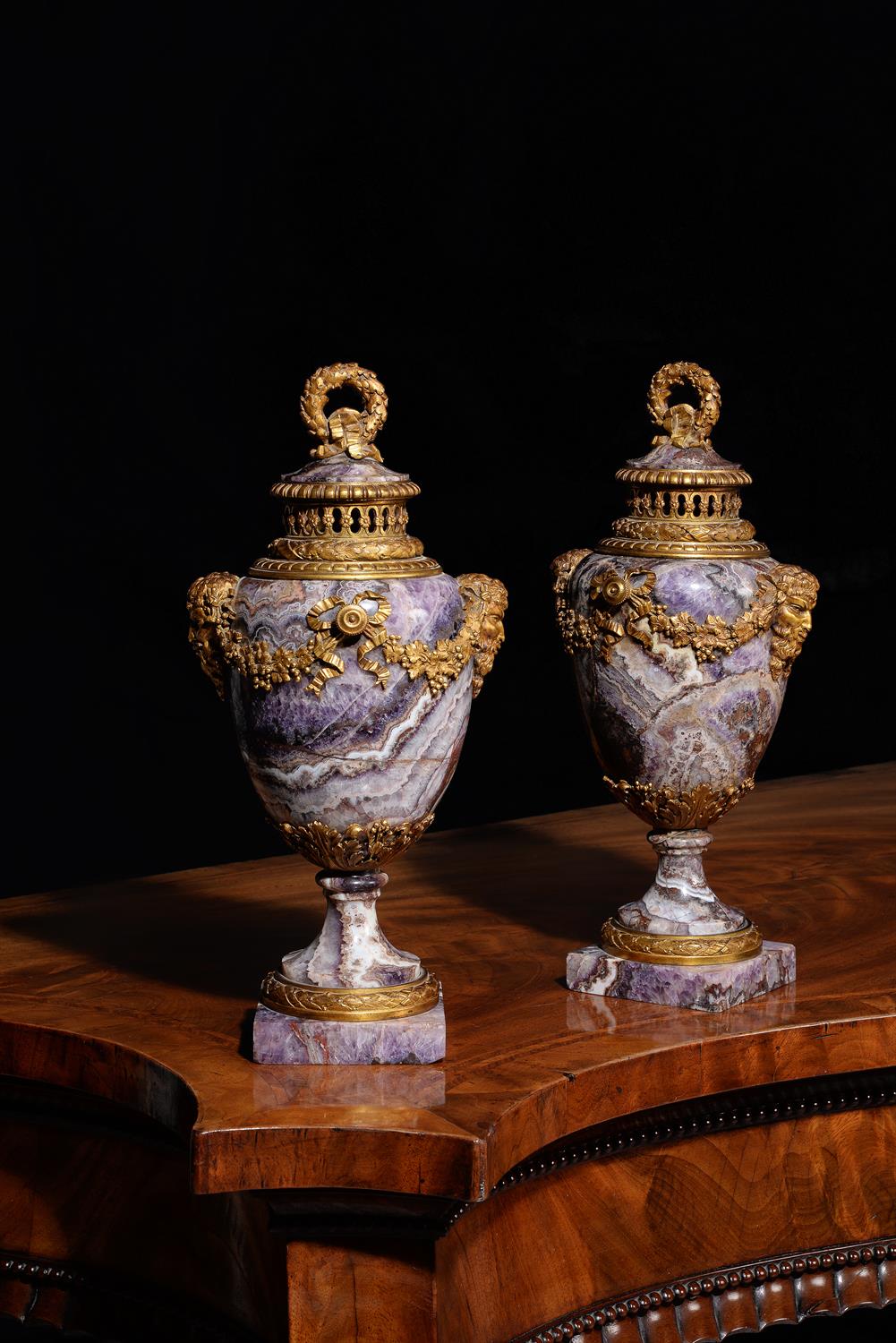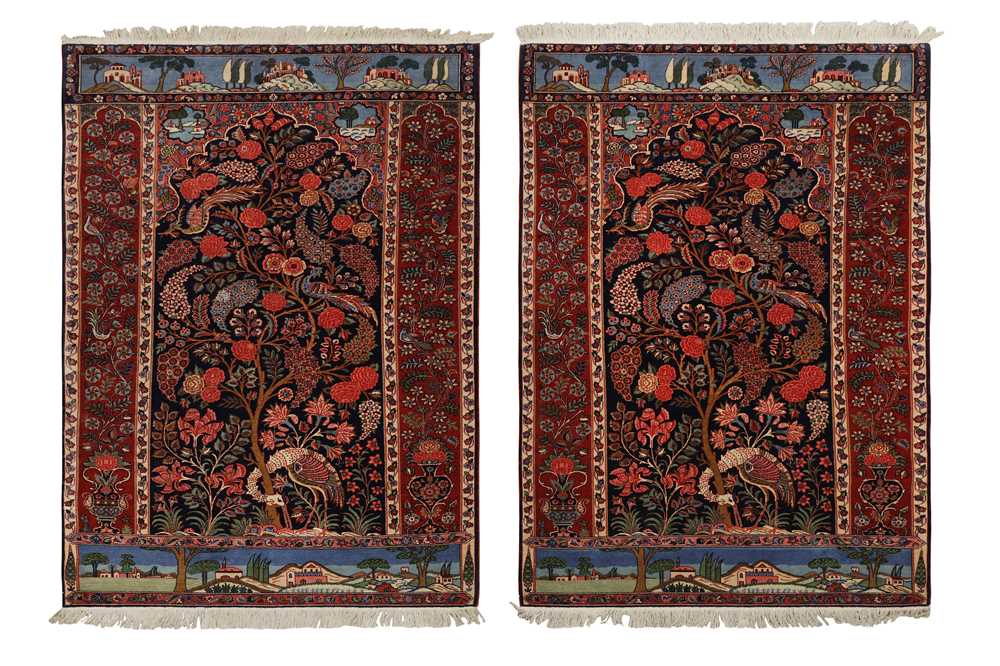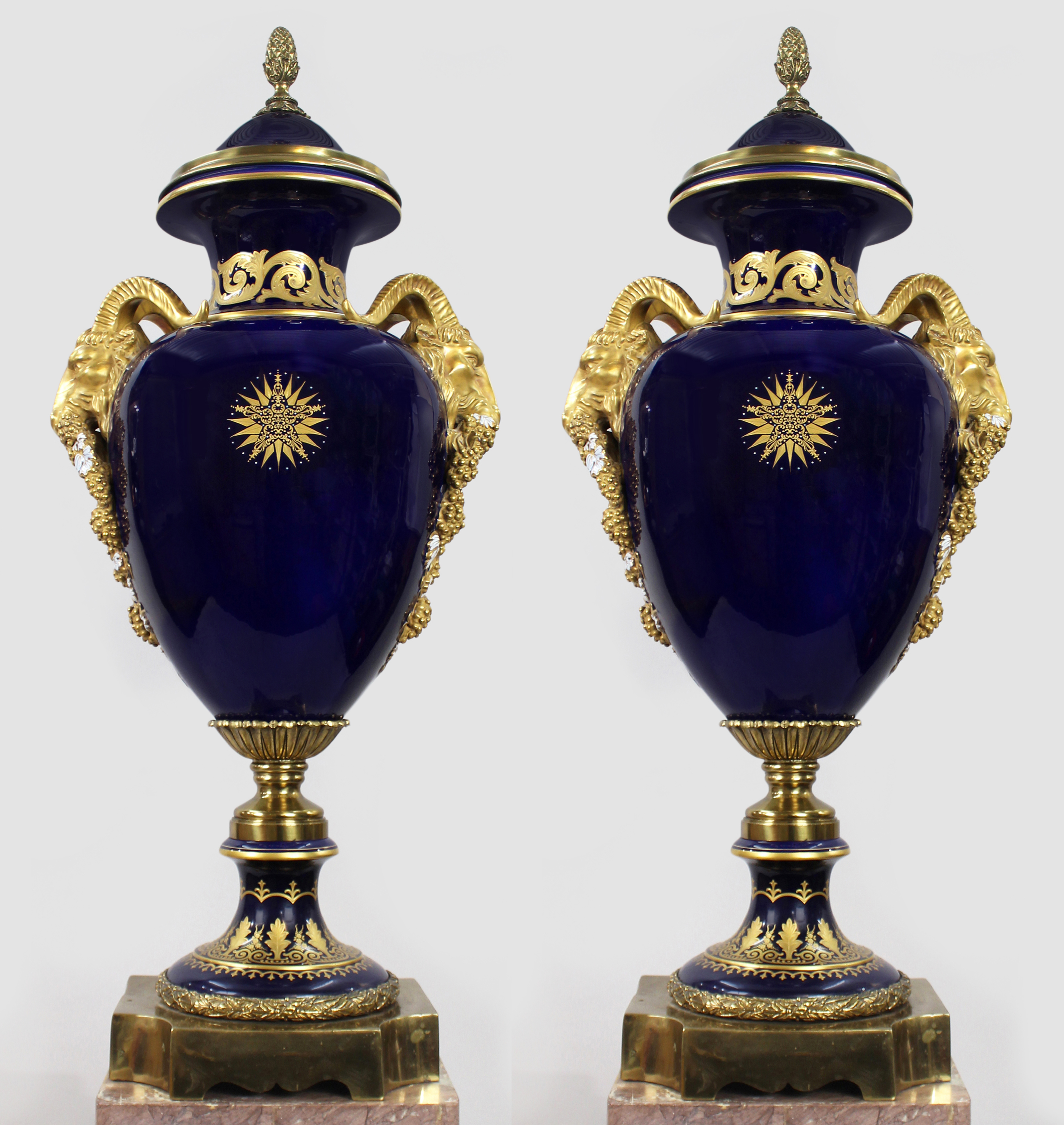A PAIR OF FINE AND RARE FRENCH LOUIS XVI ORMOLU MOUNTED WHITE MARBLE VASES AFTER THE BORGHESE VASE c.1790 each elliptical and with a beaded rim with an egg and leaf dart collar above a finely cast and chased frieze depicting in relief the thiasus, an ecstatic Bacchanalian procession with Dionysus draped with a panther skin and playing the aulos accompanied by Ariadne and various male and female figures playing castanets and musical instruments, with Dionysus supporting a drunken Silenus who is falling down reaching for a spilled flagon of wine and Dionysus holding a thyrsus with a panther at his feet, above a gadrooned body with applied stiff leaves and bulrush decoration and a pair of leaf wrapped handles, above a laurel and berry stem and an acanthus decorated socle with an outer laurel wreath, on a square plinth and a later leaf scroll decorated base with lion's paw feet (2) 44.7cm high, 26cm wide PROVENANCE Alfred de Rothschild (1842-1918) Lionel de Rothschild (1882-1942) Edmund de Rothschild (1916-2009) The Trustees of Exbury House LITERATURE Charles Davis A Description of Works of Art forming the collection of Alfred de Rothschild, 1884, pp.104-105, no.127 where illustrated. CATALOGUE NOTE The Borghese Vase is a monumental bell-shaped kylix sculpted from Pentelic marble. It was made in the second half of the 1st century BC in Greece as a lavish garden ornament for the Roman market. The vase was discovered in 1566 in the gardens of Sallust in Rome together with a Silenus with Infant Bacchus and by 1645 the vase was in the Borghese Villa. On the 27th September 1807 it was acquired by Napoleon Bonaparte and was sent to Paris and placed in the Louvre where it has remained since 1811. It is one of the most influential and admired Greek sculptural vases and was frequently copied in the 18th century with bronze reductions by Zoffoli and Righetti and other examples produced by Wedgwood and Coade. The present vases with their finely sculpted frieze copy the original closely with their depiction of Bacchanalian revelry with Dionysus supporting a drunken Silenus, an engraving of which was published by Giovanni Battista Piranesi of his 'Vasi, candelabra, cippi, sarcophagi, tripodi, Lucerne, ed ornamenti disegnati, pls. 109, 110' in 1778. However, other parts of their design borrow stylistically from the Medici vase which was first discovered in 1598 at the Villa Medici and then transferred in 1780 to the Uffizi. The use of bronze and marble in vases such as these is very rare, for comparison a related pair of Medici vases now in the Frick Collection by Luigi Valadier (1726-1785) for Madame du Barry employ the use of porphyry, gilt bronze and marble. However, the present combination was more common for the use of urns and candelabra in the Louis XVI period and echo the work of the celebrated bronzier Francois Remond and in particular a pair of four-light candelabra with bronze wrapped bodies decorated with a classical procession attributed to him, sold by Christie's, The Alexander Collection, New York, 30th April 1999, lot 135. A similar vase, just in gilt bronze and catalogued as Regency, with almost identical mounts, was sold by Sotheby's, The Collection of Mr & Mrs Stephen C. Hilbert: Important French and English Furniture, 24th May 2007, lot 59 and a Louis XVI vase in bleu turquin with similar mounts but no Bacchanalian frieze was also sold by Sotheby's, Property from the Estate of Ogden Phipps, 19th October 2002, lot 128. Read more » Confirmed Bid: £ Bid in Basket £ Place Commission Bid: Changed bid needs committing £ The minimum you can bid is £10 and all bids must be multiples of £10 Live Bid Login/Register to Bid
A PAIR OF FINE AND RARE FRENCH LOUIS XVI ORMOLU MOUNTED WHITE MARBLE VASES AFTER THE BORGHESE VASE c.1790 each elliptical and with a beaded rim with an egg and leaf dart collar above a finely cast and chased frieze depicting in relief the thiasus, an ecstatic Bacchanalian procession with Dionysus draped with a panther skin and playing the aulos accompanied by Ariadne and various male and female figures playing castanets and musical instruments, with Dionysus supporting a drunken Silenus who is falling down reaching for a spilled flagon of wine and Dionysus holding a thyrsus with a panther at his feet, above a gadrooned body with applied stiff leaves and bulrush decoration and a pair of leaf wrapped handles, above a laurel and berry stem and an acanthus decorated socle with an outer laurel wreath, on a square plinth and a later leaf scroll decorated base with lion's paw feet (2) 44.7cm high, 26cm wide PROVENANCE Alfred de Rothschild (1842-1918) Lionel de Rothschild (1882-1942) Edmund de Rothschild (1916-2009) The Trustees of Exbury House LITERATURE Charles Davis A Description of Works of Art forming the collection of Alfred de Rothschild, 1884, pp.104-105, no.127 where illustrated. CATALOGUE NOTE The Borghese Vase is a monumental bell-shaped kylix sculpted from Pentelic marble. It was made in the second half of the 1st century BC in Greece as a lavish garden ornament for the Roman market. The vase was discovered in 1566 in the gardens of Sallust in Rome together with a Silenus with Infant Bacchus and by 1645 the vase was in the Borghese Villa. On the 27th September 1807 it was acquired by Napoleon Bonaparte and was sent to Paris and placed in the Louvre where it has remained since 1811. It is one of the most influential and admired Greek sculptural vases and was frequently copied in the 18th century with bronze reductions by Zoffoli and Righetti and other examples produced by Wedgwood and Coade. The present vases with their finely sculpted frieze copy the original closely with their depiction of Bacchanalian revelry with Dionysus supporting a drunken Silenus, an engraving of which was published by Giovanni Battista Piranesi of his 'Vasi, candelabra, cippi, sarcophagi, tripodi, Lucerne, ed ornamenti disegnati, pls. 109, 110' in 1778. However, other parts of their design borrow stylistically from the Medici vase which was first discovered in 1598 at the Villa Medici and then transferred in 1780 to the Uffizi. The use of bronze and marble in vases such as these is very rare, for comparison a related pair of Medici vases now in the Frick Collection by Luigi Valadier (1726-1785) for Madame du Barry employ the use of porphyry, gilt bronze and marble. However, the present combination was more common for the use of urns and candelabra in the Louis XVI period and echo the work of the celebrated bronzier Francois Remond and in particular a pair of four-light candelabra with bronze wrapped bodies decorated with a classical procession attributed to him, sold by Christie's, The Alexander Collection, New York, 30th April 1999, lot 135. A similar vase, just in gilt bronze and catalogued as Regency, with almost identical mounts, was sold by Sotheby's, The Collection of Mr & Mrs Stephen C. Hilbert: Important French and English Furniture, 24th May 2007, lot 59 and a Louis XVI vase in bleu turquin with similar mounts but no Bacchanalian frieze was also sold by Sotheby's, Property from the Estate of Ogden Phipps, 19th October 2002, lot 128. Read more » Confirmed Bid: £ Bid in Basket £ Place Commission Bid: Changed bid needs committing £ The minimum you can bid is £10 and all bids must be multiples of £10 Live Bid Login/Register to Bid






.jpg)








Testen Sie LotSearch und seine Premium-Features 7 Tage - ohne Kosten!
Lassen Sie sich automatisch über neue Objekte in kommenden Auktionen benachrichtigen.
Suchauftrag anlegen